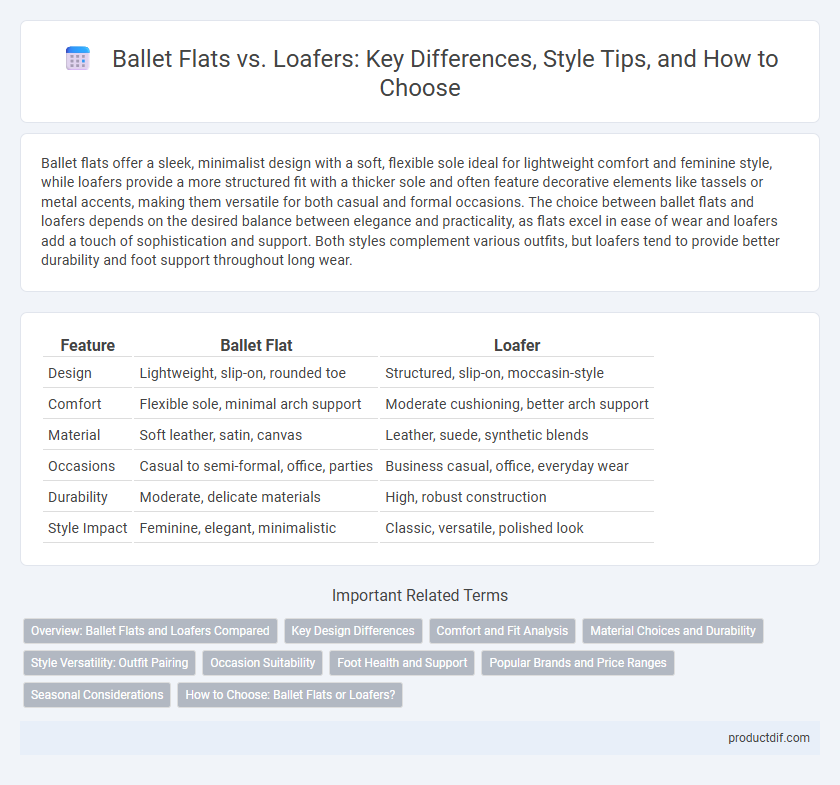Ballet flats offer a sleek, minimalist design with a soft, flexible sole ideal for lightweight comfort and feminine style, while loafers provide a more structured fit with a thicker sole and often feature decorative elements like tassels or metal accents, making them versatile for both casual and formal occasions. The choice between ballet flats and loafers depends on the desired balance between elegance and practicality, as flats excel in ease of wear and loafers add a touch of sophistication and support. Both styles complement various outfits, but loafers tend to provide better durability and foot support throughout long wear.
Table of Comparison
| Feature | Ballet Flat | Loafer |
|---|---|---|
| Design | Lightweight, slip-on, rounded toe | Structured, slip-on, moccasin-style |
| Comfort | Flexible sole, minimal arch support | Moderate cushioning, better arch support |
| Material | Soft leather, satin, canvas | Leather, suede, synthetic blends |
| Occasions | Casual to semi-formal, office, parties | Business casual, office, everyday wear |
| Durability | Moderate, delicate materials | High, robust construction |
| Style Impact | Feminine, elegant, minimalistic | Classic, versatile, polished look |
Overview: Ballet Flats and Loafers Compared
Ballet flats and loafers differ primarily in design and functionality; ballet flats feature a thin sole and a rounded toe, offering lightweight comfort ideal for casual or formal wear, while loafers are constructed with a thicker sole and a slip-on style, providing durability and support suited for business or smart-casual outfits. Materials for ballet flats often include soft leather, suede, or fabric, enhancing flexibility, whereas loafers commonly use polished leather or suede for a structured appearance. Both styles are versatile wardrobe staples, but loafers tend to offer better arch support, making them preferred for extended wear.
Key Design Differences
Ballet flats feature a rounded toe and a minimalist, slip-on design with a thin sole often made of flexible materials for lightweight comfort. Loafers typically have a moccasin-inspired construction, a more structured shape, and a thicker sole with added detailing such as tassels or metal accents. The heel height in loafers tends to be slightly elevated compared to the flat, close-to-ground profile of ballet flats.
Comfort and Fit Analysis
Ballet flats offer a lightweight, flexible fit with minimal arch support, making them ideal for short-term wear and individuals with narrow feet. Loafers provide more structured support and cushioning, enhancing comfort during prolonged use and accommodating wider foot shapes. Both styles prioritize ease of wear, but loafers generally deliver superior fit stability due to their reinforced construction and adjustable features.
Material Choices and Durability
Ballet flats often feature soft materials such as leather, suede, or fabric, prioritizing flexibility and lightweight comfort but sometimes compromising on durability with thinner soles. Loafers are typically constructed from sturdier leathers and durable synthetic materials, offering enhanced longevity and support suited for both casual and formal wear. The quality of craftsmanship and material thickness in loafers usually results in better wear resistance compared to the more delicate ballet flats.
Style Versatility: Outfit Pairing
Ballet flats and loafers each offer distinct style versatility for outfit pairing, with ballet flats lending a delicate, feminine touch ideal for dresses, skirts, and tailored pants. Loafers provide a more structured and polished look, complementing business casual attire, jeans, and even some suits, enhancing sophistication. Choosing between the two depends on the desired aesthetic and occasion, making both essential for a well-rounded footwear collection.
Occasion Suitability
Ballet flats offer a versatile option suited for casual outings, office wear, and semi-formal events due to their sleek and minimalistic design. Loafers provide a polished yet comfortable choice ideal for business settings, smart-casual occasions, and weekend gatherings, balancing style and practicality. Both footwear styles adapt well to different dress codes but differ in formality, with loafers leaning toward a more structured and sophisticated look.
Foot Health and Support
Ballet flats often lack arch support and cushioning, which can lead to foot fatigue and plantar fasciitis with prolonged wear, while loafers typically provide better structural support and padding due to their thicker soles and more substantial construction. The closed, sturdy design of loafers helps maintain proper foot alignment, reducing strain on ligaments and joints compared to the minimalistic, flexible design of ballet flats. Choosing loafers over ballet flats can contribute to better overall foot health by offering enhanced stability, shock absorption, and protection during daily activities.
Popular Brands and Price Ranges
Popular brands offering ballet flats include Tory Burch, Sam Edelman, and Rothy's, with prices generally ranging from $80 to $250 depending on materials and craftsmanship. Loafers are prominently featured by brands like Gucci, Cole Haan, and Allen Edmonds, with price ranges spanning from $150 for casual styles to over $700 for luxury leather options. Both footwear types cater to distinct style preferences and budgets, with ballet flats often favored for lightweight comfort and loafers for structured elegance.
Seasonal Considerations
Ballet flats offer lightweight comfort and breathability, making them ideal for spring and summer wear when temperatures are warmer. Loafers provide more coverage and structure, making them suitable for fall and mild winter days due to their ability to protect against cooler weather without heavy insulation. Both styles can be adapted with different materials like leather or suede to enhance seasonal functionality.
How to Choose: Ballet Flats or Loafers?
Choose ballet flats for lightweight comfort and elegant simplicity, perfect for formal events or casual wear. Opt for loafers when you need durability, support, and a polished look suitable for office environments or smart-casual outfits. Consider factors such as foot arch support, material quality, and intended use to decide between the flexible ballet flat and structured loafer styles.
Ballet Flat vs Loafer Infographic

 productdif.com
productdif.com